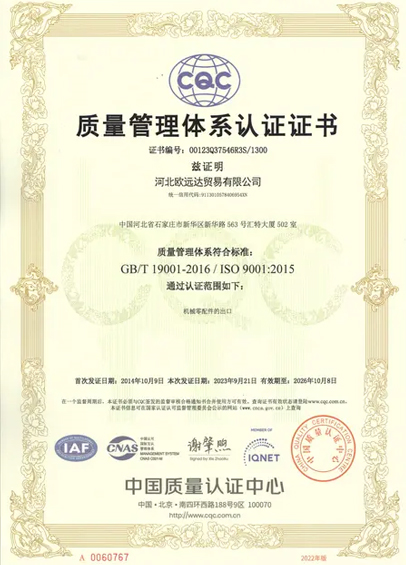Mobile:+86-311-808-126-83
Email:info@ydcastings.com
Comparative Analysis of Impellers and Turbines in Fluid Dynamics Applications
Impellers and Turbines Essential Components of Fluid Machinery
In the realm of fluid machinery, impellers and turbines serve as critical components that drive the functionality and efficiency of various systems. From the pumps that transport water to the turbines that harness wind and hydro energy, these devices are integral to modern engineering and energy management.
Understanding Impellers
An impeller is a rotating component of a centrifugal pump or fan, designed to convert rotational energy into fluid energy. Typically made of metal or plastic, it consists of blades that create a centrifugal force, propelling fluid outwards from the center of rotation. This process is crucial in applications such as water supply, irrigation, and industrial processes where moving fluids efficiently is paramount.
The design of an impeller can greatly influence the performance of a pump or fan. Factors such as the number of blades, blade shape, and rotational speed all play a role in determining the flow rate and pressure of the fluid being moved. For example, closed impellers, which have blades that are enclosed on both sides, are well-suited for high-pressure applications, while open impellers, lacking a cover, are more appropriate for moving particulates in the fluid.
Exploring Turbines
Conversely, turbines are devices designed to extract energy from fluid flow—be it steam, gas, or water. The principle of operation involves fluid flowing over blades attached to a rotor, causing it to spin and subsequently generate power. Turbines are classified into several types, including steam turbines, gas turbines, wind turbines, and hydro turbines, each serving a specific function and application.
impeller and turbine

Steam turbines, commonly employed in power generation, convert thermal energy from steam into mechanical energy. These turbines play a critical role in large-scale power plants, where they transform heat from burning fossil fuels or nuclear reactions into electricity. Similarly, gas turbines are used in jet engines and power generation facilities, known for their high efficiency and rapid startup capabilities.
Wind turbines, on the other hand, harness kinetic energy from wind, turning it into mechanical power that can be converted into electricity. As the global demand for renewable energy sources increases, wind turbines have become increasingly prevalent, contributing to cleaner energy solutions. Hydro turbines exploit the potential energy of flowing water in rivers and dams, making them vital for renewable hydroelectric power generation.
The Interconnection of Impellers and Turbines
While impellers and turbines serve distinct purposes, their principles are inherently interconnected. Both utilize the dynamics of fluid motion to perform work, whether in moving fluids or generating energy. For instance, in a hydroelectric facility, water flows through an impeller to increase its energy before it reaches the turbine, which converts that energy into electricity.
Advancements in technology have further enhanced the efficiency of both impellers and turbines. Computational fluid dynamics (CFD) allows engineers to simulate and optimize designs, leading to improved performance and reliability. Additionally, materials science plays a crucial role; lightweight, corrosion-resistant materials are being developed to enhance durability and reduce maintenance costs.
Conclusion
In summary, impellers and turbines are fundamental components that exhibit the intricate relationship between fluid dynamics and energy conversion. Their significance spans numerous industries, from water management to power generation, shaping the way we harness and utilize energy. As technology continues to evolve, these devices will become even more efficient, paving the way for sustainable practices and innovative solutions in fluid machinery. The future of energy lies in harnessing the power of these vital components to meet the growing demands of modern society.
-
Impeller Technology That Powers Precision in Pump SystemsNewsMay.22,2025
-
Valve Durability Begins with Quality Cast Iron ComponentsNewsMay.22,2025
-
Performance Cooling with Advanced Automobile Water Pump SolutionsNewsMay.22,2025
-
How Motor Housing and Oil Pans Shape Engine PerformanceNewsMay.22,2025
-
How Metal Castings Drive Modern Manufacturing EfficiencyNewsMay.22,2025
-
Exploring the Engineering Behind Valve Body CastingsNewsMay.22,2025











